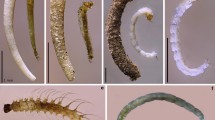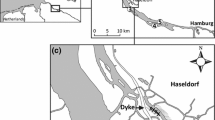Abstract
Ecologists are becoming increasingly interested in how variation in predator demographics influences prey communities. In northeastern New Zealand, the contrasting populations of previously exploited predators in highly protected marine reserves and fished areas have been used to investigate the effects of predation in soft-sediment habitats. However, these experiments have been unable to separate the role of predator size from that of density. This study provides evidence to support the model that foraging by different sizes of the rock lobster Jasus edwardsii affects soft-sediment bivalve populations in different ways. Feeding trials were conducted to investigate whether rock lobsters of different sizes vary in their choice of taxa and size of their bivalve prey. Trials with two morphologically similar species, Dosinia subrosea and Dosinia anus, indicated that lobsters of all sizes choose D. subrosea more frequently than the heavier shelled D. anus. Further results indicated that both large (>130 mm carapace length (CL)) and small (<100 mm CL) lobsters are capable of preying on a wide size range of D. subrosea (20–60 mm). However, small lobsters more frequently chose smaller shells (<30 mm) and large lobsters more frequently chose larger shells (>40 mm). Patterns in the abundance and size class distributions of these two bivalve species at protected and fished sites supported the feeding choices observed in the laboratory. These results suggest that populations of rock lobsters with large individuals inside reserves are capable of controlling the demography of bivalve populations in adjacent soft-sediment systems.




Similar content being viewed by others
References
Acosta CA, Robertson DN, (2003) Comparative spatial ecology of fished spiny lobsters Panulirus argus and an unfished congener P guttatus in an isolated marine reserve at Glover’s Reef atoll, Belize. Coral Reefs 22:1–9
Anderson MJ, ter Braak CJF (2003) Permutation tests for multi-factorial analysis of variance. J Stat Comput Simul 73:85–113
Babcock RC, Kelly S, Shears NT, Walker JW, Willis TJ (1999) Changes in community structure in temperate marine reserves. Mar Ecol Prog Ser 189:125–134
Butler MJ, MacDiarmid AB, Booth JD (1999) The cause and consequence of ontogenetic changes in social aggregation in New Zealand spiny lobsters. Mar Ecol Prog Ser 188:179–191
Castilla JC, Duran LR (1985) Human exclusion from the rocky intertidal zone of central Chile: the effects on Concholepas concholepas (Gastropoda). Oikos 45:391–399
Dayton PK, Oliver JS (1980) An evaluation of experimental analyses of population and community patterns in benthic marine communities. In: Tenore KR, Coull BC (eds) Marine benthic diversity. University of South Carolina Press, Georgetown, SC
Derby CD, Steullet P, Horner AJ, Cate HS (2001) The sensory basis of feeding behaviour in the Caribbean spiny lobster, Panulirus argus. Mar Freshw Res 52:1339–1350
Elner RW (1978) Mechanics of predation by shore crab, Carcinus maenas (L.), on edible mussel, Mytilus edulis (L.). Oecologia 36:333–344
Griffiths CL, Seiderer JL (1980) Rock lobsters and mussels: limitations and preferences in a predator–prey interaction. J Exp Mar Biol Ecol 44:95–109
Haddon M, Wear RG, Packer HA (1987) Depth and density of burial by the bivalve Paphies ventricosa as refuges from predation by the crab Ovalipes catharus. Mar Biol 94:25–30
Hilborn R, Stearns SC (1982) On inference in ecology and evolutionary biology: the problem of multiple causes. Acta Biotheor 31:145–164
Hughes RN (1980) Optimal foraging theory in the marine context. Oceanogr Mar Biol Annu Rev 18:423–481
Hughes RN, Seed R (1995) Behavioural mechanisms of prey selection in crabs. J Exp Mar Biol Ecol 193:225–238
James PJ, Tong LJ (1998) Feeding technique, critical size and size preference of Jasus edwardsii fed cultured and wild mussels. Mar Freshw Res 49:151–156
Kelly S, MacDiarmid AB, Babcock RC (1999) Characteristics of spiny lobster, Jasus edwardsii, aggregations in exposed reef and sandy areas. Mar Freshw Res 50:409–416
Kelly S, Scott D, MacDiarmid AB, Babcock RC (2000) Spiny lobster, Jasus edwardsii, recovery in New Zealand marine reserves. Biol Conserv 92:359–369
Kitching JA, Lockwood J (1974) Observations on shell form and its ecological significance in Thaisid gastropods of genus Lepsiella in New Zealand. Mar Biol 28:131–144
Langlois TJ, Ballantine WJ (2005) Marine ecological research in New Zealand: developing predictive models using no-take marine reserves. Conserv Biol 19:1763–1770
Langlois TJ, Anderson MJ, Babcock RC (2005) Reef associated predators influence adjacent soft-sediment communities. Ecology 86:1508–1519
Langlois TJ, Anderson MJ, Babcock RC, Kato S (2006) Marine reserves demonstrate trophic interactions across habitats. Oecologia 147:134–140
MacDiarmid AB (1991) Seasonal changes in depth distribution, sex ratio and size frequency of spiny lobster (Jasus edwardsii) on a coastal reef in northern New Zealand. Mar Ecol Prog Ser 70:129–141
MacDiarmid AB, Hickey B, Maller RA (1991) Daily movement patterns of the spiny lobster Jasus edwardsii (Hutton) on a shallow reef in northern New Zealand. J Exp Mar Biol Ecol 147:185–205
Mascaro M, Seed R (2000) Foraging behavior of Carcinus maenas (L.): comparisons of size-selective predation on four species of bivalve prey. J Shellfish Res 19:283–291
Mayfield S, Branch GM (2000) Inter-relationships among rock lobster, sea urchins and juvenille abalone: implications for community management. Can J Fish Aquat Sci 57:2175–2187
Mayfield S, de Beer E, Branch GM (2001) Prey preference and the consumption of sea urchins and juvenile abalone by captive rock lobsters (Jasus lalandii). Mar Freshw Res 52:773–780
Ministry of Fisheries (2005) Strategy for managing the environmental effects of fishing. Ministry of Fisheries. Wellington, New Zealand
Morton J, Miller M (1968) The New Zealand sea shore. Collins, Auckland
Paine RT (1974) Intertidal community structure: experimental studies on relationship between a dominant competitor and its principal predator. Oecologia 15:93–120
Parrish FA, Boland RC (2004) Habitat and reef-fish assemblages of banks in the Northwestern Hawaiian Islands. Mar Biol 144:1065–1073
Peters RH (1991) A critique for ecology. Cambridge University Press, Cambridge, UK
Pollock DE (1979) Predator–prey relationships between the rock lobster Jasus lalandii and the mussel Aulacomya ater at Robben Island on the Cape West Coast of Africa. Mar Biol 52:347–356
Powell AWB (1979) New Zealand mollusca. William Collins, Auckland
R Development Core Team (2004) R: a language and environment for statistical computing. R Foundation for Statistical Computing, Vienna
Robles C, Sweetnam D, Eminike J (1990) Lobster predation on mussels: shore-level differences in prey vulnerability and predator preference. Ecology 71:1564–1577
Sala E, Zabala M (1996) Fish predation and the structure of the sea urchin Paracentrotus lividus populations in the NW Mediterranean. Mar Ecol Prog Ser 140:71–81
Salierno JD, Rebach S, Christman MC (2003) The effects of interspecific competition and prey odor on foraging behavior in the rock crab, Cancer irroratus (Say). J Exp Mar Biol Ecol 287:249–260
Sanchez-Salazar ME, Griffiths CL, Seed R (1987) The effect size and temperature on the predation of cockles Cerastoderma edule (L.) by the shore crab Carcinus maenas (L.). J Exp Mar Biol Ecol 111:181–193
Shears NT, Babcock RC (2002) Marine reserves demonstrate top-down control of community structure on temperate reefs. Oecologia 132:131–142
Shears NT, Babcock RC (2003) Continuing trophic cascade effects after 25 years of no-take marine reserve protection. Mar Ecol Prog Ser 246:1–16
Smith TE, Ydenberg RC, Elner RW (1999) Foraging behaviour of an excavating predator, the red rock crab (Cancer productus Randall) on soft-shell clam (Mya arenaria L.). J Exp Mar Biol Ecol 238:185–197
Sokal RR, Rohlf FJ (1995) Biometry: the principles and practice of statistics in biological research. WH Freeman, New York, NY
Underwood AJ, Chapman MG, Connell SD (2000) Observations in ecology: you can’t make progress on processes without understanding the patterns. J Exp Mar Biol Ecol 250:97–115
Vedel JP (1986) Morphology and physiology of a hair plate sensory organ located on the antenna of the rock lobster Palinurus vulgaris. J Neurobiol 17:65–76
Weissburg MJ, Zimmerfaust RK (1994) Odor plumes and how blue crabs use them in finding prey. J Exp Biol 197:349–375
Ziegler PE, Johnson CR, Frusher SD, Gardner C (2002) Catchability of the southern rock lobster Jasus edwardsii. II. Effects of size. Mar Freshw Res 53:1149–1159
Acknowledgements
This research was supported by a scholarship to T.J. Langlois from the Education Committee, States of Jersey, Channel Islands and funds from the University of Auckland. Thanks to R.C. Babcock, W.J. Ballantine, C. Honeywill and R.B. Ford for ideas and valuable discussion.
Author information
Authors and Affiliations
Corresponding author
Additional information
Communicated by M.S. Johnson, Crawley
Rights and permissions
About this article
Cite this article
Langlois, T.J., Anderson, M.J., Brock, M. et al. Importance of rock lobster size–structure for trophic interactions: choice of soft-sediment bivalve prey. Mar Biol 149, 447–454 (2006). https://doi.org/10.1007/s00227-005-0238-4
Received:
Accepted:
Published:
Issue Date:
DOI: https://doi.org/10.1007/s00227-005-0238-4




